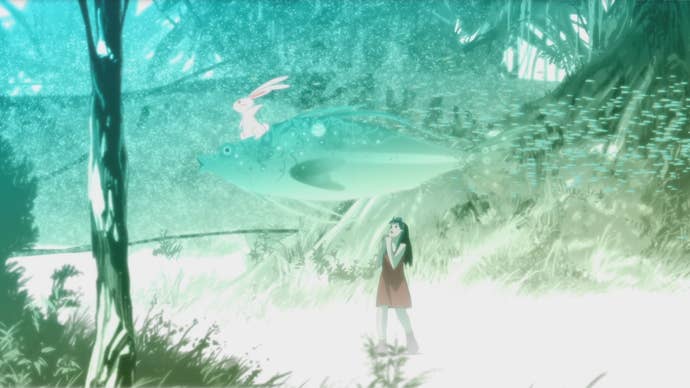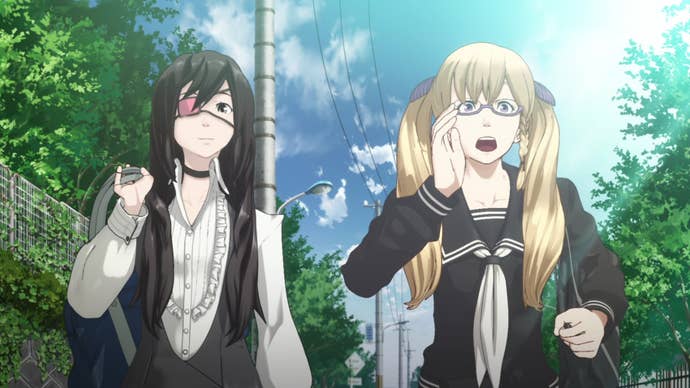Short Peace Ranko Tsukigime's Longest Day PS3 Review: Japanese Pop Culture Explosion
Yohei Kataoka and Goichi Suda take on the Japanese anime tropes you love in this punchy endless runner.
This article first appeared on USgamer, a partner publication of VG247. Some content, such as this article, has been migrated to VG247 for posterity after USgamer's closure - but it has not been edited or further vetted by the VG247 team.
Ranko Tsukigime's Longest Day is a hard game to review.
The game is one-fifth of Short Peace, a multimedia project featuring Japanese creators. Short Peace consists of four animated shorts produced by Sunrise and Shochiku plus Ranko Tsukigime's Longest Day, a game directed by Tokyo Jungle's Yohei Kataoka and written by Grasshopper Manufacturing's Goichi Suda. Everyone involved in the Short Peace is a part of the Japanese entertainment industry, but no name is bigger than the project's overseer, Akira creator Katsuhiro Otomo. The overall theme for the project is "Japan," with each creator attempting to represent a different setting and particular theme beyond that.
The animated films are a big part of the overall package, so I'll give you a quick rundown of each:

Possessions is the tale of a lonely traveler who who tries to rest in an abandoned shrine. While there, he has an unusual supernatural encounter. I found this to be the best short and someone else agreed, because it was nominated for Best Animated Short at this year's Academy Awards. Possessions is written and directed by Kakurenbo and Tokyo Ghoul director Shuhei Morita.
Combustible is written and directed by Otomo himself and presents its tale of love and firefighting in ancient Japan via animated scrolls. It has a bit of a dour ending, but it's beautiful to watch.
Gambo is the story of a white bear that comes to the aid of a small girl whose village is under attack from a demon. This is probably the most graphic of the tales: nudity, graphic violence, and a kidnapped woman with demon babies. It has a bittersweet, but expected ending. Gambo is directed by Five Numbers! director Hiroaki Ando and written by Redline creator Katsuhito Ishii.
A Farewell to Weapons is the final short and its the longest with a running time of 28 minutes (the others top out at 15 minutes). The short is based on a short story by Otomo involving a group of power-suited soldiers in post-apocalyptic Tokyo. It can drag at times, but when it gets going, it's pretty cool. A Farewell to Weapons is written and directed by long-time Gundam mecha designer Hajime Katoki, who frankly should be allowed to direct an actual Gundam series after this.

Ranko Tsukigime's Longest Day brings up the rear as the lone game in the collection. It represents the modern era of Japan and the game's theme is "mixture" according to Kataoka when we talked to him in earlier this year.
"[Suda] feels that current Japanese culture is one big mixture of a bunch of things," Kataoka said at the time. "Tokyo looks like a great big mixture of everything. Because of that, there's a bunch of creators involved in this one project. The animated parts kind of stand on their own, the scenario stands on its own, and the game stands on its own. All these different elements are glued together by that theme -- that mixture."
Longest Day is certainly a melting pot of Japanese pop culture tropes all fighting for dominance. Ranko herself is heir to the Tsukigime Express company, the leading provider of automated garages in Japan. She lives in one of the garages and when she's not going to school or practicing the violin, she's a professional hitman. (Suda loves hitmen for some reason.) Her ultimate goal is to avenge her never-seen mother by killing her father. The rest of the cast is rounded out by her friends Moeko and Kirara alongside a few secret characters.

At the basic level, Longest Day is an endless runner with limited attacks. Most of the time, Ranko has to be moving to the right of the screen, slashing and shooting targets as they pop up; stopping for too long causes The Veiled, a collection of demons or something, to kill you instantly. Ranko doesn't have a life bar either, instead she has an ammo bar with three segments. Attacking foes adds to this bar and once a segment is full you can use it to push back The Veiled for a time. Killing enemies also causes them to explode in bright Japanese art, which can damage other foes as a chain attack. Longest Day is pretty easy to pick up
It does switch things up with the boss fights: one is a vertical ascent while fighting two foes, another places you on a flying motorcycle against a dragon, and the last one is a 8-bit wrestling match. The game always keeps you moving. You could say it has a short attention span, jumping from idea to idea with little context. Longest Day is about spectacle, not telling a coherent plot, and by time to you hit the game's latter half, the wheels have come off this bus to pop-culture hell.
And it's short. The entire thing can be polished off in an hour. That can be extended by going back in the levels to try different paths, improve your clear time and score, and unlock extra like concept art and costumes.

Longest Day's strength is its sense of style. Beyond the starting character designs by Fire Emblem: Awakening and No More Heroes character designer Yuusuke Kozaki, every single cutscene is presented in a completely different style. Even game's basic art is augmented by the enemy explosions I mentioned before. They're collages of kanji and color; a long chain of attacks makes its own thumbprint on the game's visual style, like a music video or commercial come to life. Longest Day is Kataoka and Suda's trip through current Japanese entertainment in fast-forward. It careens from style-to-style, but it works. And the best part is the short running time means Suda doesn't outstay his welcome.
In the end, Longest Day isn't the main course, it's just another small part of the overall meal. You'll probably get most of the effect by watching the game on Youtube or Twitch, meaning it's important that you want the entirety of Short Peace. If you're going to pay $40, I can safely say Ranko Tsukigime's Longest Day alone is not worth the price of admission.
Short Peace is worth picking up, just to tell companies that you're into off-beat projects like this. It's a minor miracle that you can even see and play the whole thing in English. I'd probably have knocked another $10 off the price - a straight run-through of everything tops out at 3 hours total, folks - but $40 is still good if you're interested in Japanese culture and entertainment. Is Short Peace and Longest Day perfect? No, but it won't waste your time and seeing what notable Japanese creators think of Japan is an interesting diversion.

VisualsThe basic game looks okay, but the explosion of art and color pushes it forward. The cutscenes also feature various unique art styles.
SoundThe voice acting is great, but I found some of the songs a bit annoying if I left them on too long.
InterfaceIt is an interface.
Lasting AppealA single playthrough is around one hour and after that you're doing repeats to unlock extras. If that's not your thing, Longest Day is pretty short.
ConclusionRanko Tsukigime's Longest Day is an endless runner with a few attacks, but what elevates the game is the flurry of Japanese entertainment tropes and some amazing art direction. The story is nonsense, but it's just a vector to dump the art down your throat. Longest Day alone isn't worth the $40 asking price though, so if you're buying it, pick it up for the entire Short Peace package.

